May 31st, 2009 by Dr. Val Jones in True Stories
6 Comments »
My primary care physician has a cash-only medical practice, and he is paid by the hour for whatever he does – be it a phone call, email, office visit, house call, or outpatient surgical procedure. He doesn’t charge higher prices for procedure complexity – that’s factored into the time it takes to complete the procedure. It’s a wonderful model for those of us who’ve chosen high deductible health insurance plans, and pay cash for primary care services. My husband and I save thousands of dollars/year with our plan, and spend a few hundred of that savings to cover our primary care needs. We also have our family physician available to us 24-7 via phone/email, and can generally see him for an in-person visit within hours of a request for one.
Yesterday was a perfect example of the incredible convenience of this model of care – I called Dr. Dappen at 10:30am and asked if we could come in to have a sebaceous cyst removed from my husband’s back. Dr. Dappen said he’d be happy to see us at 11:30am that day, so we hopped in a car and were finished with the procedure by 12:00. I even had fun taking photos for the blog (see below)…
Cost of the procedure: (surgery plus supplies): $150
Days spent waiting for an appointment: 0
Time spent in a waiting room: 0 minutes
Convenience of having a cash-only family physician: priceless
*For more information, check out: Doctokr Family Medicine, Vienna, Virginia*
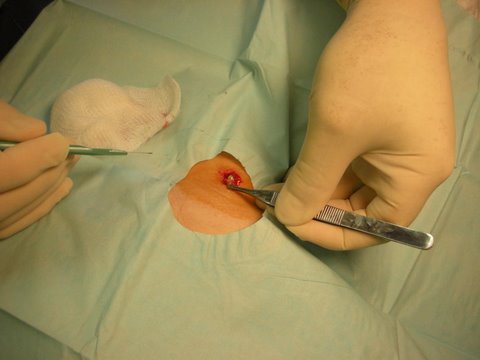
Pearly appearance of small sebaceous cyst
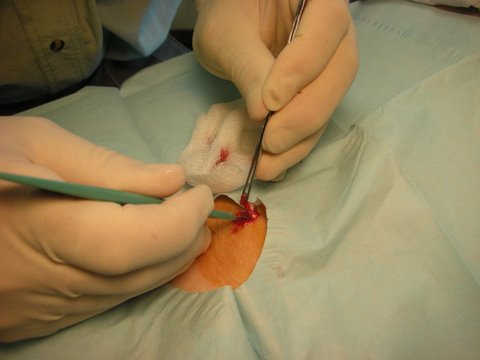
Excision of sebaceous cyst
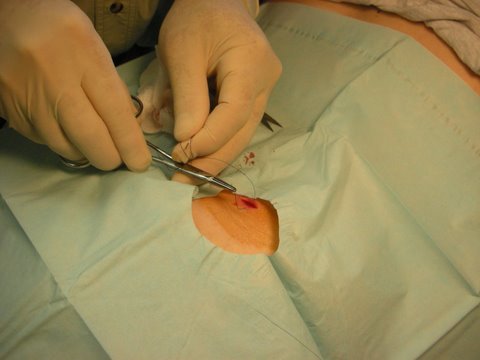
Wound closure with simple sutures
May 19th, 2009 by RamonaBatesMD in Better Health Network, Health Tips
No Comments »

Being a plastic surgeon, I have a great interest in the skin and no I don’t see or treat much dermatitis as the primary physician. Patients do occasionally ask me about patches/rashes they have. It’s always nice to be up on the topic and to know when it’s important to make sure they see a dermatologist.
The article listed below is a nice, simple review of conditions that fall into the eczema /dermatitis categories. The article discusses atopic dermatitis (AD), nummular (coin-shaped) eczema, contact dermatitis, and stasis dermatitis. It is not a deep article on the subject, but did include some nice reminders and tips.
Allergic dermatitis is not uncommon in patients with chronic wounds. One study documented more than 51% of leg ulcer patients acquire contact allergic dermatitis to local dressings and other topical treatment. This is important to any of us who treat wounds, acute or chronic. Sometimes the wound fails to heal due to this.
There is a nice table which lists the common allergens in patients with chronic wounds. If your chronic wound patient has a contact allergy to these products, it can certainly complicate their wound healing.
-
lanolin (common in moisturizing creams and ointments)
-
perfumes/fragrances
-
cetylsterol alcohol (used as an emulsifier, stabilizer, and preservative in creams, ointments, and paste bandages)
-
preservatives: quaternium 15, parabens, chlorocresol (all are used to prevent bacterial contamination in creams, but are not in ointments)
-
rosin (colophony) — a component of some adhesive tapes, bandages, or dressings
-
rubber / latex
The key to treatment and prevention of future exacerbations is identification of any provocative factors so that they may be avoided as there is no absolute cure for dermatitis. Here is a summary of tips the article gives:
Laundry and Clothing Suggestions
-
Avoid wearing wool or nylon next to their skin as they may exacerbate itch. Choose materials made of cotton or corduroy which are softer.
-
Rather than use fabric softeners and bleach, which may be irritating to the skin, add a white vinegar rinse in the washing machine rinse cycle cup/dispenser to remove excess alkaline detergent.
Moisturizers
-
Keep water exposure to a minimum.
-
Use humectants or lubricants regularly to replenish skin moisture. Apply these agents immediately after bathing while the skin is damp.
-
For severe hand eczema, cotton gloves may be worn at night to augment the moisturizing effect of humectants and other topical treatments.
Topical Steroids
-
Topical steroids continue to be the mainstay therapy for treating dermatitis.
-
Topical steroid creams can be kept in the refrigerator or combined with 0.5% to 1% of menthol (camphor and phenol are alternatives) to give a cooling effect. This often helps.
-
Treat the dermatitis with a topical steroid when the skin is red and inflamed. Tapering the topical steroid use by alternating with moisturizers as the dermatitis resolves.
-
Remember that percutaneous absorption of topical steroids is greatest on the face and in body folds. They suggest only weak or moderate preparations be used in these areas.
-
Moderate to potent topical steroids should be used on the trunk and the extremities.
-
The palms and soles are low-absorption areas, so may require very potent topical steroids
REFERENCE
The ABCs of Skin Care for Wound Care Clinicians: Dermatitis and Eczema; Advances in Skin & Wound Care: May 2009, Vol 22, Issue 5, pp 230-236; Woo, Kevin Y. RN, MSc, PhD, ACNP, GNC(C), FAPWCA; Sibbald, R. Gary BSc, MD, MEd, FRCPC (Med, Derm), ABIM DABD, FAPWCA (doi:10.1097/01.ASW.0000350837.17691.7f)
*This blog post was originally published at Suture for a Living*
May 12th, 2009 by RamonaBatesMD in Better Health Network
No Comments »

The U.S. Food and Drug Administration recently announced that safety label changes including a boxed warning and a Risk Evaluation and Mitigation Strategy (REMS) will now be required for all botulinum toxin products. The agency took the action because of two main reasons. The first one is the potential for serious risks that may occur from the spread of the botulinum toxin beyond the injection site. The second reason is associated with the lack of interchangeability among the three licensed botulinum toxin products.
When the botulinum toxin spreads beyond the area of injection, symptoms similar to botulism may occur. These symptoms include unexpected loss of strength or muscle weakness, hoarseness or trouble talking, trouble saying words clearly, loss of bladder control, trouble breathing, trouble swallowing, double vision, blurred vision and drooping eyelids.
This “spreading effect” has been reported in both children and adults. It has been reported most often in children with cerebral palsy being treated with the products for muscle spasticity. Treatment of muscle spasticity is an off-label use of the drug. The “spreading effect” has been reported in patients being treated for both approved and unapproved uses.
Botulinum toxin products include:
-
Botox and Botox Cosmetic (botulinum toxin type A), marketed by Allergan
-
Myobloc (botulinum toxin type B), marketed by Solstice Neurosciences
-
Dysport (abobotulinumtoxinA), a new FDA-approved product marketed by Ipsen Biopharm Ltd.
All are approved by the FDA for the treatment of cervical dystonia. Botox Cosmetic and Dysport are approved by the FDA for treatment of glabellar frown lines. Botox is approved for the treatment of severe underarm sweating (primary axillary hyperhidrosis), crossed eyes (strabismus), and abnormal tics and twitches of the eyelids (blepharospasm). All other uses are considered off-label.
The FDA has not identified any definitive serious adverse event reports of a distant spread of toxin effect producing symptoms consistent with botulism when these products are used in accordance with the approved label.
It is important for those of us who use botulinum toxins to remember that the dosage strength between the products is not the same. One unit of Botox is not equal in strength (potency) as one unit of Myobloc or Dysport.
BOTOX® Cosmetic Insert (pdf)
Dilution Technique: Using a 21-gauge needle and an appropriately sized syringe draw up a total of 2.5 mL/100 Unit vial or 1.25 mL/50 Unit vial of 0.9% sterile saline without a preservative…….
Injection Technique: Glabellar
Using a 30-gauge needle, inject a dose of 0.1 mL into each of 5 sites, 2 in each corrugator muscle and 1 in the procerus muscle for a total dose of 20 Units. Typically the initial doses of reconstituted BOTOX® Cosmetic induce chemical denervation of the injected muscles one to two days after injection, increasing in intensity during the first week.
MYOBLOC® Insert (pdf)
The recommended initial dose of MYOBLOC® for patients with a prior history of tolerating botulinum toxin injections is 2500 to 5000 U divided among affected muscles. Patients without a prior history of tolerating botulinum toxin injections should receive a lower initial dose. The duration of effect in patients responding to MYOBLOC® treatment has been observed in studies to be between 12 and 16 weeks at doses of 5000 U or 10,000 U.
Dysport® Insert
The units of Dysport are specific to the preparation and are not interchangeable with other preparations of botulinum toxin.
Glabellar lines Dosage
The dosage is dependant on the severity of the lines and the specific muscle being treated.
For the corrugator and procerus muscles 40 to 60 units divided between injection sites as follows:
8 to 12 units in each of 5 sites, 2 in each corrugator muscle and 1 in the procerus muscle for a total dose of 60 units
Improvement of severity of glabellar lines generally occurs within 72 hours after treatment and persists for 3 to 6 months.
It is important for us to educate patients and their caregivers of the potential adverse effects. Some of these effects have been reported as early as several hours and as late as several weeks after treatment. Patients should seek immediate medical attention if they develop any of these symptoms — unexpected loss of strength or muscle weakness, hoarseness or trouble talking, trouble saying words clearly, loss of bladder control, trouble breathing, trouble swallowing, double vision, blurred vision and drooping eyelids.
Adverse events may be reported by health care professionals and/or consumers to the FDA’s MedWatch Adverse Event Reporting program by four ways:
REFERENCES
FDA News (April 30, 2009)
BOTOX® Injections; eMedicine Article, Sept 25, 2008; Robert A Hauser, MD, MBA, Mervat Wahba, MD, Theresa McClain, MSN, ARNP
*This blog post was originally published at Suture for a Living*
April 24th, 2009 by Dr. Val Jones in Humor
No Comments »
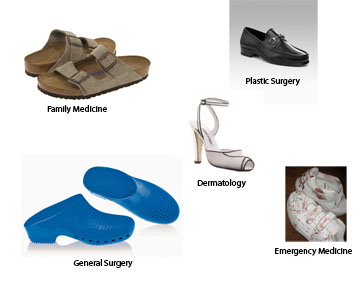
I’m currently at a medical conference for my specialty, Physical Medicine and Rehabilitation. I happened to look around at everyone’s shoes and realized that many medical specialties can probably be identified by the types of shoes they wear. Check out the footwear at your next conference and tell me if I’m on to something. And by the way, this is more or less what rehab docs wear on their feet:
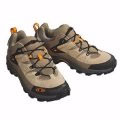
April 24th, 2009 by RamonaBatesMD in Better Health Network, Health Tips
3 Comments »
I have a nephew who has excess sweating of his feet which began as a child. The problem has not gone away as he got older, nor has it spread to other parts of his body. He has tried the new socks that say they will absorb sweat and keep the feet dry. None of them work for him. So this post is for him as I look for ways to help him.
Sweating is the release of a salty liquid from the body’s sweat glands. Sweating or perspiration is important in cooling the body. It is common to sweat under the arms, on the feet, and on the palms of the hands.
When the production of sweat is in excess of the amount needed for cooling the body (thermal regulation) it is call hyperhidrosis (excess sweating).
Hyperhidrosis may be primary or secondary. Primary (essential) hyperhidrosis is excess sweating in an otherwise healthy individual, like my nephew.
When excessive sweating affects the hands, feet, and armpits, it’s called primary or focal hyperhidrosis. Primary hyperhidrosis affects 2 – 3% of the population. Less than 40% of patients with this condition seek medical advice. In the majority of primary hyperhidrosis cases, no cause can be found. It appears to run in families.
Secondary hyperhidrosis is associated with any number of systemic illnesses. These including pheochromocytoma, thyrotoxicosis, diabetes mellitus, diabetes insipidus, hypopituitarism, anxiety, menopause, carcinoid syndrome, and drug withdrawal. Nocturnal sweating, in particular, may be a clue to the diagnosis of tuberculosis, lymphoma, endocarditis, diabetes, or acromegaly. Treatment of the underlying disease will decrease or cease the excess sweating in secondary hyperhidrosis.
Several common medications occasionally produce hyperhidrosis. These include tricyclic and serotonin reuptake inhibitors, opioid analgesics, acyclovir, and naproxen.
When looking for underlying health issues, it is important to know if there are any triggers (stress, anxiety, food, etc), if the sweating occurs mostly at night or during the day, which areas of the body are involved, is there an elevated body temperature, or any other problems.
You should see your doctor, if:
-
You sweat a lot or if sweating lasts for a long time or can’t be explained.
-
Sweating occurs with or is followed by chest pain or pressure.
-
Sweating is accompanied by weight loss or most often occurs during sleep and associated with a fever.
Treatments may include:
-
Antiperspirants. Excessive sweating may be controlled with strong anti-perspirants, which plug the sweat ducts. Products containing 10% to 15% aluminum chloride hexahydrate are the first line of treatment for underarm sweating. Antiperspirants can cause skin irritation. The strong doses of aluminum chloride can damage clothing.
-
Medication. Anticholinergics drugs, such as glycopyrrolate (Robinul, Robinul-Forte) are rarely helpful. Beta-blockers or benzodiazepines may help reduce stress-related sweating.
-
Iontophoresis. This FDA-approved procedure uses electricity to temporarily turn off the sweat gland. It is most effective for sweating of the hands and feet. The hands or feet are placed into water, and then a gentle current of electricity is passed through it. The electricity is gradually increased until the patient feels a light tingling sensation. The therapy lasts about 10-20 minutes and requires several sessions. Side effects include skin cracking and blisters, although rare.
-
Botox. Botulinum toxin type A (Botox) was approved by the FDA in 2004 for the treatment of severe underarm sweating, a condition called primary axillary hyperhidrosis. Small doses of purified botulinum toxin injected into the underarm temporarily block the nerves that stimulate sweating. Side effects include injection-site pain and flu-like symptoms.
-
Endoscopic thoracic sympathectomy (ETS). In severe cases, a minimally-invasive surgical procedure called sympathectomy may be recommended. The procedure is usually performed on patients with excessively sweaty palms. It is not as effective on those with excessive armpit sweating. This surgery turns off the signal which tells the body to sweat excessively. ETS surgery is done while the patient is asleep under general anesthesia. The surgery takes about a half hour. Patients usually go home the next day, but may experience pain for about a week. ETS requires special training so make sure your doctor is properly trained. Risks include artery damage, nerve damage, and increased sweating. New sweating occurs in about 50% of patients.
References
Goldman L, Ausiello D. Cecil Textbook of Medicine, 22nd ed. Philadelphia, Pa: WB Saunders; 2004:2365, 2446-2447.
Hyperhidrosis; eMedicine, May 2, 2008; Robert A Schwartz, MD, MPH, Rachel Altman, MD, George Kihiczak, MD
*This blog post was published originally at Suture For A Living.*


















